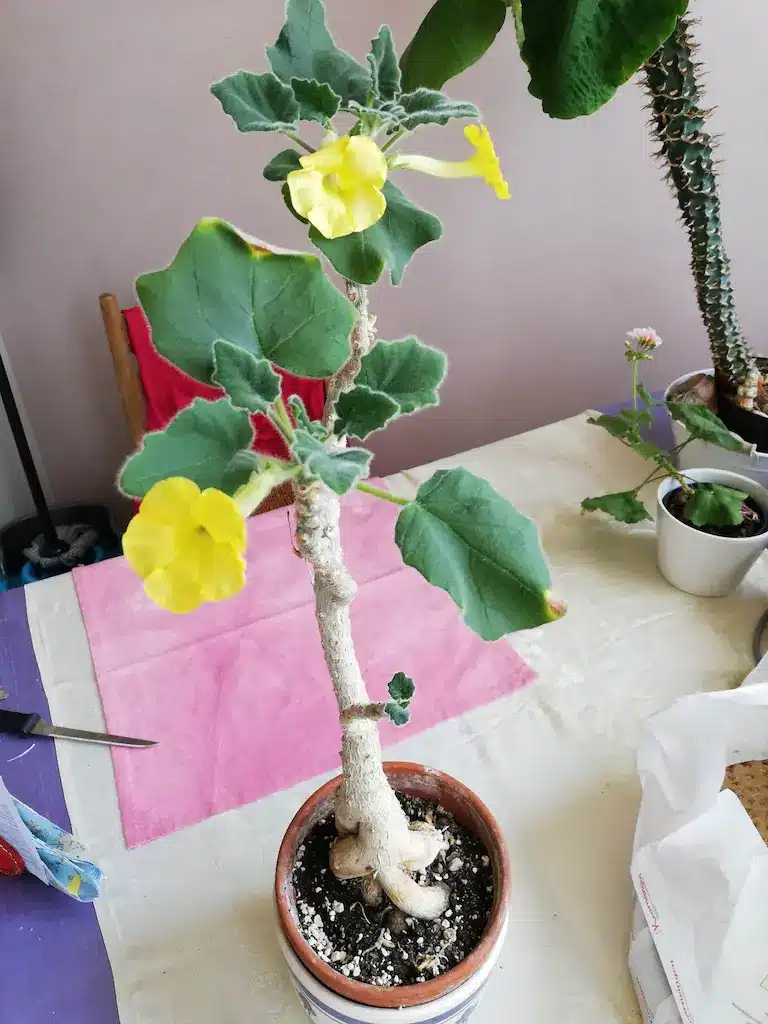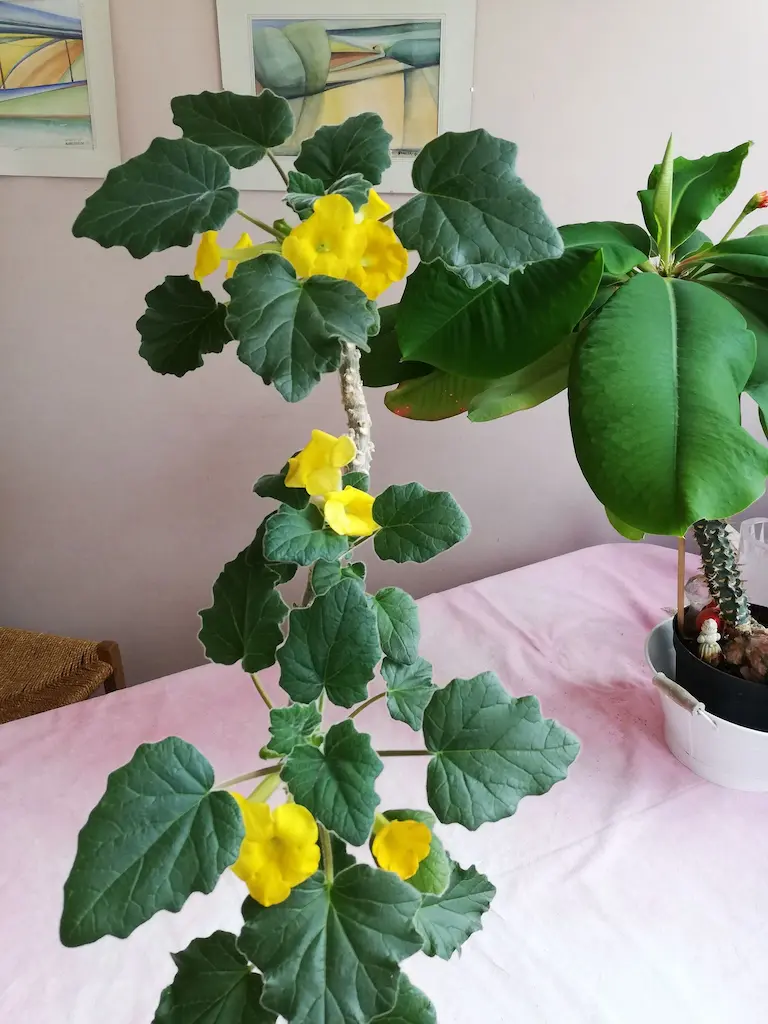All about Uncarina plant Care

Uncarina Roeoseliana and a Euphorbia Viguieri in the back
Key takeaways - Uncarina
-
Common Plant Name
- Uncarina
-
Botanical Name
- Uncarina spp.
-
Botanical Family
- Pedaliaceae
-
Plant Type
- Shrub or small tree
-
Mature Size
- Varies by species, up to 10 feet
-
Sun Exposure
- Full sun to partial shade
-
Soil Type
- Well-draining, sandy or loamy
-
Soil pH Neutral
- Slightly acidic to neutral
-
Bloom Time
- Summer to early fall
-
Flower Color
- Yellow to orange
-
Hardiness Zones
- 9 to 11
-
Native Region
- Madagascar, some species in Africa
Uncarina is a fascinating succulent that brings an exotic touch to your garden or indoor space. It has a very eye-catching shape with a large caudex and continuous flowering all summer long. Uncarina is a genus of the plant family Pedaliaceae that originates from the tropical island of Madagascar. It is a very easy exotic plant to grow even in the northern hemisphere, yet very rare to find. It has a very high tolerance to conditions that contradict its natural climate, such as long winter months with very limited daylight.
This article is based on Uncarina Roeoesliana, which is the most common of the Uncarina species.
Uncarina is a rather small succulent tree that grows to a couple of feet tall (around 50 cm). Although, its very close relative, Uncarina Grandidieri (Mousetrap Tree), with a similar appearance but is much larger in size, up to 10 feet tall.
How To Guide - Grow and care for Uncarina plants
To ensure your Uncarina thrives and flourishes, it’s essential to provide the right conditions. In this guide, we will explore the best soil, temperature, pot, watering, and nutrition requirements for cultivating healthy and vibrant Uncarina plants.
Fertilizer
Uncarina thrives in lean soils and doesn’t require excessive fertilization. During the active growing season (usually spring and summer), you can use a diluted balanced liquid fertilizer every two to four weeks. Use a succulent or cactus fertilizer with an NPK ratio of 10-10-10 or even lower nitrogen. Be sure to follow the instructions on the fertilizer packaging and avoid overfertilizing, which can cause nutrient burn. In the dormant winter period, it’s best to refrain from fertilizing.
Best Soil for Uncarina
Uncarina thrives in well-draining soil that resembles its natural habitat. The ideal mix includes a rich succulent or cactus potting soil combined with perlite or coarse sand. Uncarina is not as picky for a well-draining medium as many other succulents. This blend promotes proper drainage, preventing waterlogging of the roots. Aim for a slightly acidic to neutral pH level, between 6.0 and 7.0, which suits the plant’s preferences.
The right temperature for Uncarina
Uncarina originates from Madagascar, where it enjoys warm and dry conditions. To replicate its natural environment, maintain temperatures between 65°F (18°C) and 85°F (29°C). During winter, it’s crucial to protect the plant from temperatures below 50°F (10°C) to avoid cold stress or damage. They are not cold hardy and cannot endure temperatures below 35 2° F (2°).
Placing your Uncarina near a sunny window or in a well-ventilated greenhouse can help maintain the desired temperature range.
Best light
The best light for a happy Uncarina plant is full sun to partial shade. It is a very easy plant to overwinter indoors in colder climate since it has a very high tolerance for long periods of bad daylight. It will cruise through the dark winter months in a semi-dormant state like nothing happened. Once spring arrives, it will show signs of life with new green leaves emerging.
Uncarina does not need extra light during the dark winter months, and is perfectly fine to keep sitting on the windowsill all year long.

Uncarina Roeoseliana caudex
Ideal Pot for Uncarina
When choosing a pot for your Uncarina, opt for one with drainage holes to prevent water accumulation and root rot. The pot should be slightly larger than the plant’s current root system to allow for future growth. Since Uncarina Roeoseliana has a taproot, deep pots are preferable to accommodate its root structure. Clay or terracotta pots are excellent choices as they provide better airflow and help prevent overwatering by allowing the soil to dry more efficiently.
Water Uncarina
Uncarina likes abundant watering during growing season. But the pot must have drainage holes, as overwatering can lead to root rot and other issues. Uncarina is a drought-tolerant succulent, so it’s crucial to find the right balance between providing adequate moisture and preventing waterlogging.
Water your Uncarina deeply but infrequently, allowing the soil to completely dry out between waterings. The frequency will depend on factors like temperature and humidity. Always check the moisture level a few inches below the soil surface before watering. If given too much water or sitting in water, the leaves will start to hang and give you a very clear sign that something is wrong.
Uncarina Dormancy
Sometimes the Uncarina plant doesn’t loose all the leaves during the winter dormancy, and they tend to smell pretty bad for some reason. During active growth, there is no particular smell from the plant or the very furry leaves. There is no need to give a winter-dormant Uncarina almost any water until spring, maybe just a splash once per month.
How to make Uncarina plants flower
Trigger Uncarina plants to bloom is usually very easy. Once it wakes up from dormancy during spring, feed it a balanced fertilizer (NPK 10-10-10) and you will soon be rewarded with plenty of small flower buds emerging from the trunk next to the hairy leaves. Once the first yellow Uncarina flower appears, it will diligently produce flowers all summer long until roughly Sep/Oct. Just stick to the water regimen mentioned in the article and you will have a happy plant.
If you are able to successfully pollinate your Uncarina plant, very large and unusual seed pods will emerge from the dry flowers. Large black and spiky balls will decorate an already beautiful plant and give it another level of sophistication. The seedpods have small hooks that will attach themselves to an animal that unknowingly will help spread the genus of Uncarina in the local area. The plant will generously provide you with plenty of seeds, to grow even more plants yourselves, or give away to curious neighbours.
It took my Uncarina Roeoseliana roughly one year from seed germination to flower for the first time, which occurred late in the fall just before dormancy. It was just one flower, so it never gained the characteristic flowering momentum until the following spring.
From the 2nd year onwards, it flowers profusely like clockwork all summer long. Despite going through a very long annual dormancy of a prolonged period of very little sunlight.

Uncarina Roeoesliana flowers
Repotting Uncarina
With a green thumb and some botanical engineering, you can turn your Uncarina plant into an amazing caudiciform stem and impressive root system elevated above the soil the first repotting. When you repot an Uncarina plant for the first time after two years or even earlier since it is a fast grower in the early stages. You will discover that the plant has very thick roots, which can be elevated above the soil when repotting. Repot Uncarina a couple of inches (a few centimetres) above the soil, compared to before. Suddenly you have an amazing-looking natural bonsai with powerful roots that almost fills up the whole pot, along with a never-ending production of beautiful yellow flowers.
Repot the plant at the beginning of the growing season when it is about to gain positive momentum.
Pruning
Uncarina plants are usually rather easy going in terms of trimming and pruning. They grow fairly slow don’t invade the space around or make too much of a mess. But keep an eye open for any dry leaves, allowing new growth, and sculpting the plant for visual appeal. Additionally, the removal of spent flowers invigorates the emergence of new flower buds. Consistent pruning not only elevates the visual splendour of Uncarina but also cultivates a more robust and flourishing plant.
Grow Uncarina from seed
Propagating Uncarina from seeds is quite easy.
- Bury the seeds slightly below the surface in a light seed-starting soil in a small pot suitable for seedlings.
- Room temperature above 70 °F (20°C) is ideal.
- Cover the plant with a plastic bag for a few weeks and the seeds will eventually sprout and see the world.
- Poke small holes in the plastic back and allow the plant to slowly acclimatize to the indoor humidity.
- Make sure that the pot, soil and plastic bag is sterilized with diluted peroxide to increase chances of high survival rates and avoid diseases.
Propagate Uncarina from cuttings
You can also propagate Uncarina cuttings. But since Uncarina seeds germinate readily and grow rather fast, there isn’t really a demand for different propagation methods.
Uncarina species:
Other Uncarina species have a strong resemblance to Uncarina Roeoesliana, which this article is based on, but lack the same true caudex.
- Uncarina Grandidieri, is a small tree native to Madagascar that grows up to 4 meters tall
- Uncarina Stellulifera, resembles Roeoesliana to a large degree but has pink flowers instead of yellow.
- Uncarina Peltate, can get a bit taller than Roeoesliana and also has yellow flowers.
Common Pests & Plant Diseases
While Uncarina plants typically are rather resilient, they can be sensitive to certain pests and diseases. Keep an eye open for common pests such as mealybugs, aphids, or spider mites. Additionally, remain attentive to the possibility of fungal infections, particularly in humid conditions. Ensure proper air circulation and avoid overwatering as preventive measures against issues like root rot.
Overwintering Uncarina
Overwintering Uncarina plants is very straightforward. Just keep it in room temperature and it will be fine. If the plant is outdoors during the summer, make sure the winters are warm enough or relocate it indoors to a well-ventilated greenhouse or near a sunlit window to sustain the recommended temperature range.
Interesting Knowledge about Uncarina
Uncarina Grandidieri is used for their traditional medicinal uses by indigenous communities for hair care and dandruff treatment.
Challenges with Uncarina
All in all, it is a very easy plant to grow, overwinter, and trigger flowering. But one fairly common issue with Uncarina plants is overwatering. These succulents, native to Madagascar, are adapted to arid conditions and prefer well-draining soil to prevent the plant from sitting in water.
Conclusion
Growing Uncarina can be a truly rewarding experience, and providing the ideal conditions is key to its success. By ensuring the right soil composition, temperature range, pot selection, watering routine, and balanced nutrition, you can cultivate healthy and vibrant Uncarina plants. Keep a close eye on your plant’s needs and adjust your care accordingly, taking into account its specific requirements. With proper attention and care, your Uncarina will thrive and become a beautiful addition to your plant collection or garden.
The Uncarina speices are a rather easy and forgiving plant family that tolerates conditions very different from its natural habitat. Yet, it is a very rare plant to find in common homes. As long as it´s not exposed to freezing temperatures during the winter, it will most likely be happy to flower the following spring.
FAQ - Uncarina plants
Most frequent questions and answers
Uncarina Roeoesliana is a very good indoor plant that is easy take care of, even outside its natural climate zones. It adjusts well to shorter days in the north.
Uncarina starts off with rather rapid growth after sprouting from seed for about a coupble of years. Followed by a rather slow growth for the rest of its life.
Uncarina is a succulent plant with its very thick caudex and root system, also the leaves are relatively thick and juicy.
Uncarina is a very easy plant to grow, and adjusts to most indoor conditions as long as it is positioned by a sunny window in room temperature.
